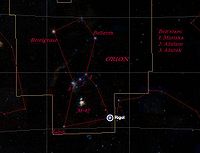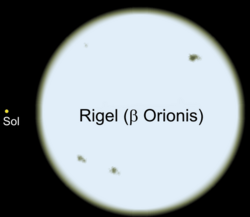Rigel
 From Conservapedia
From Conservapedia | Rigel | |
|---|---|

| |
| Observational Data | |
| Designation | 19 Ori, β Ori, HD34085 |
| Right ascension | 05h 14m 32.2721s[1] |
| Declination | −08° 12′ 05.8981″[1] |
| Constellation | Orion |
| Type of object | Blue supergiant |
| Dimensions | 78 solar radii |
| Magnitude | Apparent amg: 0.18[1] Absolute Mag: -6.69[2] |
| Astrometry | |
| Distance from Earth | 870 ly[3] |
| Radial velocity | 17.8 ± 0.4 km/s[1] |
| Proper motion | RA: 1.31 mas/yr[1] Dec.: 0.50 mas/yr[1] |
| Parallax | 3.78 ± 0.34 mas[1] |
Rigel, also known as Beta Orionis, is a blue-white supergiant star located in, and part of, the constellation of Orion.[3] Rigel is actually Rigel A, the primary star of a binary star system. Rigel is the brightest star in the Orion constellation as well as the sixth brightest star overall in the night sky with an apparent magnitude of 0.18.[1]
Rigel in History[edit]
The traditional name of Rigel stems from its location in the Orion constellation. The name is derived from the Arabic Riǧl Ǧawza al-Yusra, meaning "Left foot of the Central One", as the star is seen as the "left foot" of constellation. Another Arabic name for the star is riǧl al-ǧabbār or "the foot of the great one". In Western culture, the star traditionally represents the left foot of the mythical hunter Orion of Greek mythology. Usually the The foot is mistakenly associated with Beta Eridani, which is really one of the stars that represents his footstool. The Chinese referred to the star as 参宿七 or Shēnxiù Qī, meaning "The Seventh of the Three Stars".
Rigel is also one of the most important stars used in celestial navigation throughout the history of oceanic sailing. This is due to both the star's relative brightness and its equatorial location, making it visible in most ocean latitudes.
Star System[edit]
Rigel is actually a binary star system, although only the primary star can be seen from Earth by the unaided eye. It was first discovered as such in 1831 by F. G. W. Struve who was able to resolve the companion star with his telescope, despite the overwhelming brightness of its primary.
As the Rigel system is far beyond the distance a star can be precisely measured using parallax measurements, its distance can only be estimated. The star is believed to be between 700 and 900 light-years distant.[3][2] The Hipparcos probe has estimated the distance to be some 860 light years distant.[4]
The primary star is so bright that it illuminates the dust clouds in nearby nebula, the most famous being the Witch head nebula 40 AU away.[5]
Rigel A[edit]
Rigel A is classified as a blue-white supergiant of spectral class B8 Iab. The star contains some 17 times the mass of our Sun. While the radius of Rigel is estimated to be 74 times that of the Sun, so large, that if Rigel was at the center of our solar system, it would extend to the orbit of Mercury.[4] The star has 40,000 times the Sun's visual luminosity.[4] Much of Rigel's radiation however, is in the ultraviolet, when this is accounted for, the star's total luminosity is 47,000 times the Sun's.[3]
Like other stars of its category, Rigel burns through its core hydrogen very quickly. Rigel will soon burn through its hydrogen fuel in the core, if it hasn't already done so, and will eventually expand to become a red supergiant. Given Rigel's mass, it will most likely end its life in a supernova explosion. If Rigel does go supernova, it will appear as bright as a quarter moon.
Rigel B[edit]
Rigel B is a class B9 V star of magnitude 6.7, making it just slightly too dim to be seen with the unaided eye, even if the star was alone.[6] Because Rigel A is some 500 times as bright, Rigel B is obscured by its companion, making observations challenging. Rigel B itself is some 2500 AU from its primary (or some 60 times the distance Pluto is from the Sun) taking 25,000 years to orbit.[4]
Some astronomers have claimed that Rigel B itself is actually a double, and if so would more accurately be called Rigel BC. However the idea of Rigel B being a double star in itself is still highly controversial, with proponents unable to repeatedly duplicate their initial results.[6]
There is also a 15th magnitude class K star, referred to as Rigel D, believed to be associated with the other stars of the Rigel system. It is estimated to be some 11,500 AU from Rigel A and its companion, and if part of the system, would take some 250,000 years to orbit the primary.[4]
References[edit]
- ↑ 1.0 1.1 1.2 1.3 1.4 1.5 1.6 1.7 Rigel from the SIMBAD Astronomical Database
- ↑ 2.0 2.1 Rigel. Retrieved on 2019-01-25.
- ↑ 3.0 3.1 3.2 3.3 Rigel. Retrieved on 2019-01-25.
- ↑ 4.0 4.1 4.2 4.3 4.4 Rigel. Archived from the original on 2009-07-24. Retrieved on 2019-01-25.
- ↑ Rigel: Orion's Brightest Star. Retrieved on 2019-01-25.
- ↑ 6.0 6.1 Jedicke, Peter; Levy, David H. (1992). "Regal Rigel". The New Cosmos. Waukesha: Kalmbach Books. pp. 48–53.
Categories: [Astronomy] [Stars] [Double Stars]
↧ Download as ZWI file | Last modified: 02/28/2023 14:24:34 | 4 views
☰ Source: https://www.conservapedia.com/Rigel | License: CC BY-SA 3.0
 ZWI signed:
ZWI signed:
 KSF
KSF